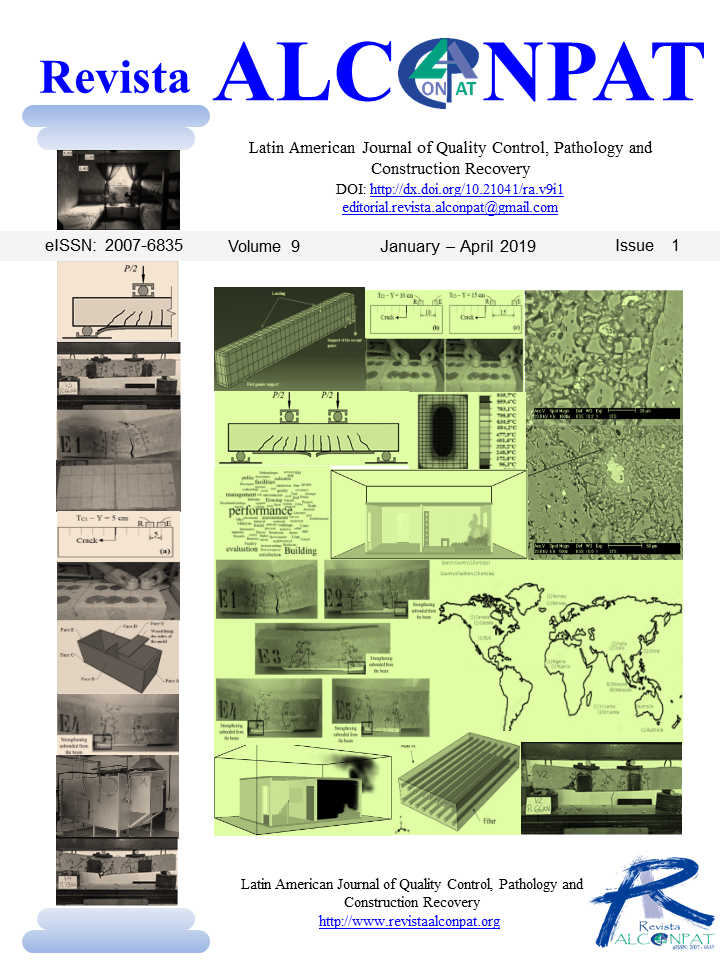Systematic review the criteria for Building Performance Evaluation (BPE)
DOI:
https://doi.org/10.21041/ra.v9i1.260Keywords:
performance, evaluation, criteria, construction, systematic reviewAbstract
The objective of this article is to provide, through a systematic review of the literature focused on quality control of buildings, a consistent database to present the criteria most used by the Building Performance Evaluation (BPE). Through this review, 782 articles were identified, of which 15 were selected considering the subject's adherence to the research and publication period. The main information about the articles, their authors and journals was discussed. The performance criteria compiled by the analyzed articles used as basis: literature, questionnaires and interviews with users and professionals of the area, consultation with specialists in the segment and technical visits to buildings. With these identified criteria it was possible to define 9 dimensions of analysis that are discussed and presented in this document.
Downloads
References
Biernacki, P.; Waldorf, D. (1981), “Snowball Sampling: problems and technique of chain referral sampling”. Sociological Methods & Research, v.10, n.2, p.141-163.
Elyna Myeda, N., Nizam Kamaruzzaman, S., & Pitt, M. (2011), “Measuring the performance of office buildings maintenance management in Malaysia”. Journal of Facilities Management, 9(3), 181-199.
Gopikrishnan, S., & Topkar, V. M. (2015), “Attributes and descriptors for building performance evaluation”. HBRC Journal.
Hashim, A. E., Aksah, H., & Said, S. Y. (2012). “Functional assessment through post occupancy review on refurbished historical public building in Kuala Lumpur”. Procedia-Social and Behavioral Sciences, 68, 330-340. doi: https://doi.org/10.1016/j.sbspro.2012.12.231.
Ibem, E. O., Opoko, A. P., Adeboye, A. B., & Amole, D. (2013), “Performance evaluation of residential buildings in public housing estates in Ogun State, Nigeria: Users' satisfaction perspective”. Frontiers of Architectural Research, 2(2), 178-190. http://dx.doi.org/10.1016/j.foar.2013.02.001.
Khan, S., & Kotharkar, R. (2012), “Performance evaluation of school environs: Evolving an appropriate methodology building”. Procedia-Social and Behavioral Sciences, 50, 479-491. doi: 10.1016/j.sbspro.2012.08.052.
Khalil, N. A. H. Nawawi. (2008), “Performance assessment of government and public buildings via post occupancy evaluation”. J. Asian School Sci. 4 (9)103–112.
Khalil, N., Kamaruzzaman, S. N., & Baharum, M. R. (2016), “Ranking the indicators of building performance and the users’ risk via Analytical Hierarchy Process (AHP): case of Malaysia”. Ecological Indicators, 71, 567-576. http://dx.doi.org/10.1016/j.ecolind.2016.07.032.
Kim, S., Yang, I., Yeo, M., Kim, K. (2005), “Development of a housing performance evaluation model for multifamily residential building in Korea”. J. Build. Environ. 40,1103–1116.
Kitchenham, B., Brereton, O. P., BUDGEN, D., Turner, M., Bailey, J., Linkman, J. (2009), “Systematic Literature Reviews in Software Engineering: a systematic literature review”. Information and Software Technology, v. 51, n. 1, p. 7-15.
Koleoso, H., Omirin, M., Adewunmi, Y., & Babawale, G. (2013), “Applicability of existing performance evaluation tools and concepts to the Nigerian facilities management practice”. International Journal of Strategic Property Management, 17(4), 361-376. doi: https://doi.org/10.3846/1648715X.2013.861367.
Lai, J. H., & Man, C. S. (2017), “Developing a performance evaluation scheme for engineering facilities in commercial buildings: state-of-the-art review”. International Journal of Strategic Property Management, 21(1), 41-57. http://dx.doi.org/10.3846/1648715X.2016.1247304.
Lavy, S., Garcia, J. A., & Dixit, M. K. (2010), “Establishment of KPIs for facility performance measurement: review of literature”. Facilities, 28(9/10), 440-464. https://doi.org/10.1108/02632771011057189.
Støre-Valen, M., & Lohne, J. (2016), “Analysis of assessment methodologies suitable for building performance”. Facilities, 34(13/14), 726-747.: https://doi.org/10.1108/F-12-2014-0103
Mohit, M. A., & Azim, M. (2012), “Assessment of residential satisfaction with public housing in Hulhumale’, Maldives”. Procedia-Social and Behavioral Sciences, 50, 756-770. doi: https://doi.org/10.1016/j.sbspro.2012.08.078.
Meir, I. A., Garb, Y., Jiao, D., Cicelsky, A. (2009), “Post-occupancy evaluation: an inevitable step toward sustainability”. Advances In Building Energy Research 3, 189–220.
Meng, X., & Minogue, M. (2011), “Performance measurement models in facility management: a comparative study”. Facilities, 29(11/12), 472-484. https://doi.org/10.1108/02632771111157141.
Nazeer, S. F; De Silva, N. (2016), “TBPE scoring framework for tropical buildings”. Built Environment Project and Asset Management, Vol. 6 Issue: 2, pp.174-186, https://doi.org/10.1108/BEPAM-09-2014-0049.
Nik-Mat, N. E. M., Kamaruzzaman, S. N., & Pitt, M. (2011), “Assessing the maintenance aspect of facilities management through a performance measurement system: A Malaysian case study”. Procedia Engineering, 20, 329-338. https://doi.org/10.1016/j.proeng.2011.11.174.
Preiser, W. F. E. (1994), “Built environment evaluation: conceptual basis, benefits and uses”. J. Archit. Plann. Res. 11, 91–107.
Steinke, C., Webster, L., & Fontaine, M. (2010), “Evaluating building performance in healthcare facilities: an organizational perspective”. HERD: Health Environments Research & Design Journal, 3(2), 63-83.
Talib, Y., Yang, R. J. Priyadarsini Rajagopalan. (2013), “Evaluation of building performance for strategic facilities management in healthcare: A case study of a public hospital in Australia”. Facilities, Vol. 31 Issue: 13/14, pp.681-701, https://doi.org/10.1108/f-06-2012-0042.
Teicholz, E. (2003), “Rationale and challenge”. In: Teicholz, E. (Ed.), Facility design and management handbook, The McGraw-Hill Companies, Inc.
Vischer, J. C. (2008), “Towards a user centred theory of built environment”. J. Build. Res. Inform. 36 (3) 231–240.
Published
How to Cite
Issue
Section
License
_______________________________
License in effect from September 2020
You are free to:
- Share — copy and redistribute the material in any medium or format for any purpose, even commercially.
- Adapt — remix, transform, and build upon the material for any purpose, even commercially.
- The licensor cannot revoke these freedoms as long as you follow the license terms.
Under the following terms:
- Attribution — You must give appropriate credit , provide a link to the license, and indicate if changes were made . You may do so in any reasonable manner, but not in any way that suggests the licensor endorses you or your use.
- No additional restrictions — You may not apply legal terms or technological measures that legally restrict others from doing anything the license permits.
Notices:
You do not have to comply with the license for elements of the material in the public domain or where your use is permitted by an applicable exception or limitation .
No warranties are given. The license may not give you all of the permissions necessary for your intended use. For example, other rights such as publicity, privacy, or moral rights may limit how you use the material.





















.png)














